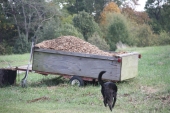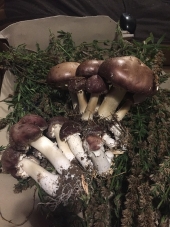

 2
2




Some places need to be wild










 1
1




Some places need to be wild














Some places need to be wild










 3
3




Some places need to be wild














Some places need to be wild

 4
4




List of Bryant RedHawk's Epic Soil Series Threads We love visitors, that's why we live in a secluded cabin deep in the woods. "Buzzard's Roost (Asnikiye Heca) Farm." Promoting permaculture to save our planet.














Some places need to be wild














Some places need to be wild














Some places need to be wild










 7
7




Some places need to be wild




Bryant RedHawk wrote:
What I'm going to recommend at this point in your wood chip compost is to add bacteria, most likely you have plenty of mycelium growing in that heap but fungi like to feed on bacteria left overs and bacteria use enzymes to break down lignin which is what gives wood its structure.
If you have some fermented vegetable matter going (bokashi) or if you don't, it is fairly easy to grow some good bacteria to add to your wood chip heap, this will speed up the breakdown.
Ways to grow bacteria:
Rice Base (EM) - rinse and part cook about a cup of rice (boil 2 cups water and use 1 1/2 cup rice), this is less water than that much rice needs to fully cook, when the water is almost adsorbed by the rice, turn off the heat and add cool water to stop the cooking process.
Pour that rice/water mixture into a pail and add 1 cup soured milk (have an almost out of date jug in the fridge? that is perfect if you do), stir this mixture and set a lid on the pail, put in a fairly warm spot. Check in three days, it should be ready to pour onto the wood chip heap.
The Bokashi style - use a 5 gal pail and toss your scrap vegetable materials in at every prep session, once there is enough to fill the pail 3/4 full add some (1. near out or out of date milk, or 2. one single serving of plain yogurt), stir in and again set a cover on the pail and place in a warmish spot. (this takes about a week)
Fridge clean out method - have any fuzzy items in the fridge? this is a good time to simply toss those onto the wood chip heap and work them under the surface a bit.
There are three easy peasy methods to get some good bacteria into that wood chip heap.
Once the bacteria are multiplying along, the fungi will be able to get more of the foods it loves and needs to grow quickly.
This will work on all your wood chip heaps.
I wrote up some faster methods for making the biodynamic style preparations (they are easy access on the soil forum at the top)
Redhawk










 1
1




Some places need to be wild
















 5
5




List of Bryant RedHawk's Epic Soil Series Threads We love visitors, that's why we live in a secluded cabin deep in the woods. "Buzzard's Roost (Asnikiye Heca) Farm." Promoting permaculture to save our planet.
 3
3














 4
4




Some places need to be wild










 7
7




Some places need to be wild












 3
3




List of Bryant RedHawk's Epic Soil Series Threads We love visitors, that's why we live in a secluded cabin deep in the woods. "Buzzard's Roost (Asnikiye Heca) Farm." Promoting permaculture to save our planet.














Some places need to be wild












 3
3




List of Bryant RedHawk's Epic Soil Series Threads We love visitors, that's why we live in a secluded cabin deep in the woods. "Buzzard's Roost (Asnikiye Heca) Farm." Promoting permaculture to save our planet.
 5
5




PURPLE CARDS! GET YOUR GARDENING CARDS HERE!! https://www.kickstarter.com/projects/paulwheaton/garden-cards?ref=4qylf3. "The only thing...more expensive than education is ignorance."~Ben Franklin. "We can easily forgive a child who is afraid of the dark; the real tragedy of life is when men are afraid of the light." ~ Plato










 1
1




Some places need to be wild
 2
2




PURPLE CARDS! GET YOUR GARDENING CARDS HERE!! https://www.kickstarter.com/projects/paulwheaton/garden-cards?ref=4qylf3. "The only thing...more expensive than education is ignorance."~Ben Franklin. "We can easily forgive a child who is afraid of the dark; the real tragedy of life is when men are afraid of the light." ~ Plato










 1
1




Some places need to be wild










 1
1




Some places need to be wild














Some places need to be wild















Some places need to be wild














Some places need to be wild










 1
1




Some places need to be wild














Some places need to be wild










 1
1




Some places need to be wild










 1
1




Some places need to be wild










 1
1




Some places need to be wild
















List of Bryant RedHawk's Epic Soil Series Threads We love visitors, that's why we live in a secluded cabin deep in the woods. "Buzzard's Roost (Asnikiye Heca) Farm." Promoting permaculture to save our planet.














Some places need to be wild
















List of Bryant RedHawk's Epic Soil Series Threads We love visitors, that's why we live in a secluded cabin deep in the woods. "Buzzard's Roost (Asnikiye Heca) Farm." Promoting permaculture to save our planet.














Some places need to be wild
 2
2














 3
3




Some places need to be wild




The original Silicon Valley hillbilly.


|
Did you ever grow anything in the garden of your mind? - Fred Rogers. Tiny ad:
The new permaculture playing cards kickstarter is now live!
https://www.kickstarter.com/projects/paulwheaton/garden-cards
|






